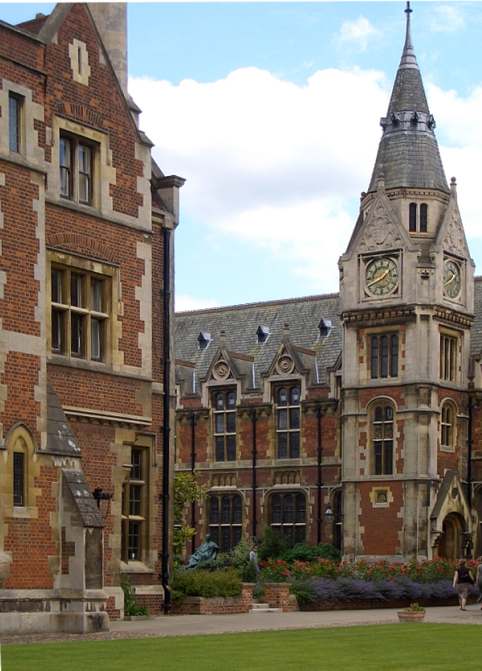Photographs by the author. You may use these images without prior permission for any scholarly or educational purpose as long as you (1) credit the photographer and (2) link your document to this URL in a web document or cite the Victorian Web in a print one.


The Trumpington Street frontage: street view of the Red Buildings, Pembroke College. Alfred Waterhouse (1830-1905). 1875-77. Red brick and stone. Courtyard, Red Buildings. [Click on images to enlarge them.]
Nikolaus Pevsner writes witheringly of Waterhouse's work at Pembroke that this architect was the last person "to be guided by respect for the character of old work. In every case where he added at Pembroke he spoiled something that was already there and replaced it by something out of keeping with Cambridge" (127). As for what was already there, Pembroke College originally had a compact "Old Court," the first of its kind in Cambridge, which included all the buildings needed for a college (Chapel, Library, Hall, accommodation etc), and the south and east parts of this had to be pulled down for the Victorian rebuilding programme (see Rawle, who shows a seventeenth-century print of the Old Court, 72). As for what Waterhouse put in its place, this has provoked even sharper criticism from other architectural historians. Reginald Turnor, for example, slating Waterhouse for his lack of taste, finds his work at Pembroke and Caius "hard to forgive." In fact, says this critic, "Waterhouse ruined Pembroke. His brick and stone and fatuous turrets insult its Wren chapel as abusively as its medieval courts, and the whole thing is a mess — a monument to tastelessness and misplaced assurance" (Turnor 91-92). Matters could, however, have been worse: Colin Cunningham writes that Waterhouse's "wish to provide a complete new set of buildings for Pembroke College was frustrated by an emerging respect for historical structures, and that college actually sacked him as its architect."


The Pembroke College Library and the Library clocktower.
Look at the street frontage here as a whole, as the older building gives way to Wren and then to Waterhouse. Compare Turnor's highly negative assessment of Waterhouse's work at Pembroke with Charles Eastlake's apologia for the same architect's work at Balliol College, Oxford. Was Eastlake right? Has "the hand of time" done much to relieve the disjunctions here?

Pembroke's older buildings.
Related material
Sources
Pevsner, Nikolaus. The Buildings of England: Cambridgeshire. Harmondsworth: Penguin, 2nd ed. 1970.
Rawle, Tim. Cambridge Architecture. London: Deutsch, 1985.
Created 2008; last modified 23 June 2015